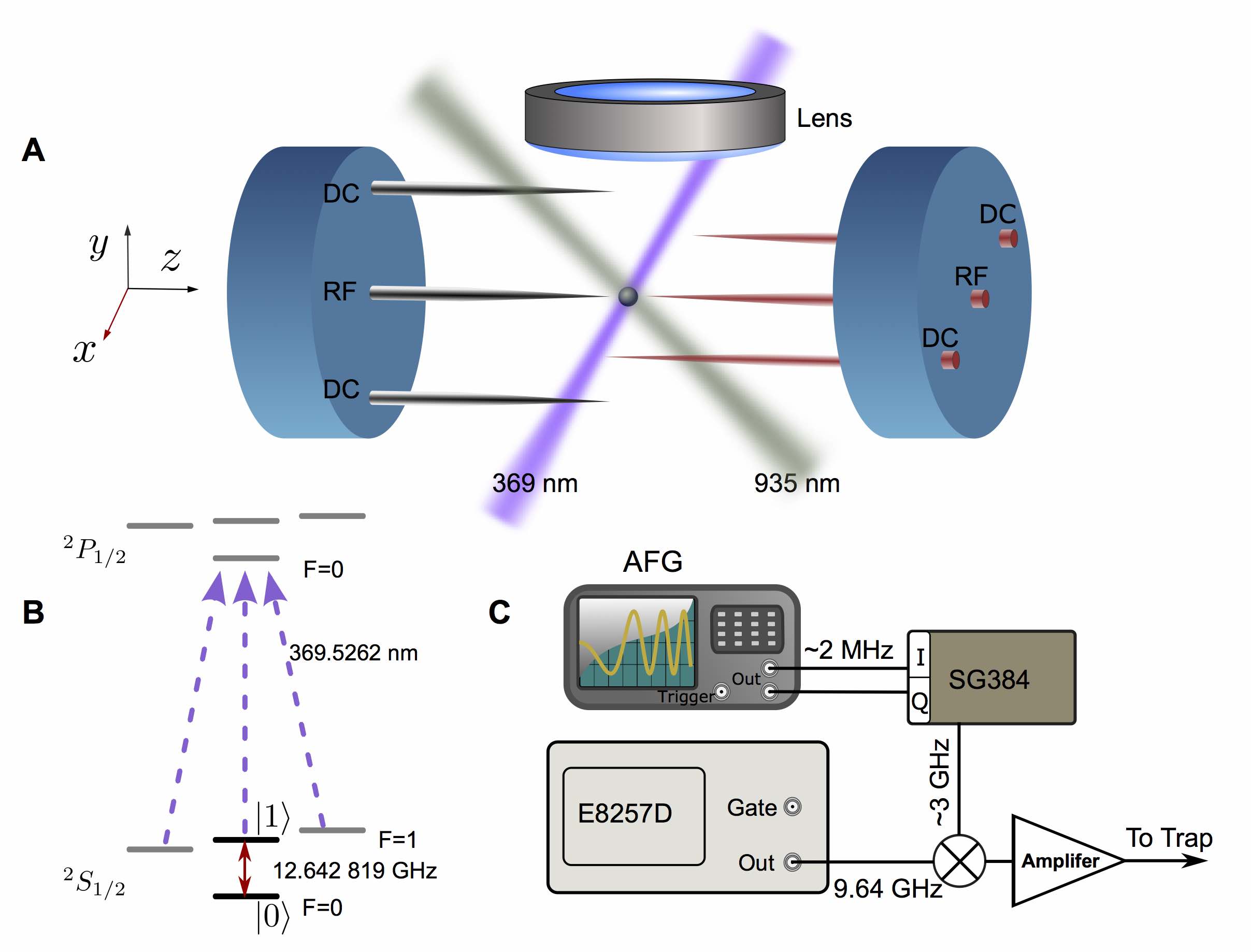We published a quantum simulation work on Scientific report as "Experimental Trapped-ion Quantum Simulation of the Kibble-Zurek dynamics in momentum space". This is the first experiment work on trapped ion in our group. We start to build the ion trap experiment in 2013, and many efforts have been done build the platform. We would like to thank to our collaborators Le Luo and Adolf de Campo, who give us help on both experiment and theory. Congratulations!
Find the article in this link : http://www.nature.com/articles/srep33381
About the work
The study of nonequilibrium dynamics of quantum systems forms a vast field of research of relevance to a wide variety of disciplines ranging from cosmology to condensed matter, as well as quantum simulation and computation, to name just a few prominent examples.

Fig.1. Experimental setup using an ion-trap. ( A ) Configuration of six needles of the trap used in experiment. (B) Yb+ energy spectrum: the hyperfine energy levels (|0> and |1>) of the ground state are used as the qubit. (C) Microwave control scheme of the driving field around 12.642 GHz: the frequency is generated by mixing microwaves between 9.64 GHz and 3 GHz, while 3 GHz microwave is IQ modulated by a dual channel AFG around 2 MHz.
T. W. B. Kibble’s most cited contribution to science dates back to 1980 and ignited an explosion of interest in the field. He predicted in a cosmological setting that breaking of symmetry is governed by causality, and that topological defect formation is to be expected with the crossing of a continuous phase transition, which is ineluctably nonadiabatic. It was W. H. Zurek who refined these arguments soon after and turned the study of universal critical dynamics into an experimentally testable discipline. He predicted that the density of defects after crossing a continuous phase transition in a condensed matter system scales as a universal power law with the quench rate, where the power-law exponent is given by the equilibrium critical exponents and the dimensionality of the system. To this date, the Kibble-Zurek mechanism remains the predilect paradigm to account for the dynamics of a continuous phase transition.
The last three decades have deeply sharpened our understanding of the universal dynamics and broken symmetries. Yet, two recent thorough reviews written by Kibble, Zurek and one of us (AdC) pointed out that a conclusive experimental test remains elusive to this date [J. Phys.: Condens. Matter 25, 404210 (2013), Int. J. Mod. Phys. A 29, 1430018 (2014)]. This uneasy state of affairs can be understood after appreciating the formidable challenges and requisites involved in experimental studies: exquisite control of the system parameters over a large range of values to test the power-law behavior of the density of defects, knowledge of the correlation length and dynamic critical exponents, clean and large samples without relevant disorder, inhomogeneity or finite-size effects, reliable measurement of topological defects, etc.
Remarkably enough, and with no exception, previous experimental studies are either restricted to the classical regime [Nat. Phys. 9, 656–660 (2013), Nat. Commun. 4, 2291 (2013)], or none firm supporting of the KZ theory in quantum regime is given [PRL 106 235304 (2011)], PRL 107, 140402 (2011)]. The prospects for experimental tests in quantum systems are shadowed by the additional requirement of ground state cooling that appears as an insurmountable obstacle with current quantum technologies.
In this work, we embrace Feynman’s idea of quantum simulation to experimentally test the universal critical dynamics of a quantum spin chain using a trapped ion in momentum space. This allows us to study the universal dynamics of a clean, homogenous, large sample initialized in its quantum ground state. We focus on the paradigmatic transverse field Ising chain, the cornerstone to understand quantum phase transitions. We report the experimental evidence of universal scaling of the density of excitations after crossing at a finite rate the quantum critical point of the paramagnetic-ferromagnetic phase transition. The accurate measurement of the resulting density of excitations allows us to experimentally verify the applicability of the Kibble-Zurek mechanism in the quantum regime.